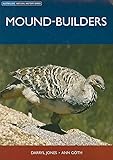- HubPages»
- Education and Science»
- Life Sciences»
- Endangered Species
Dusky Scrubfowl: Nest Mound-Builder Bird from Indonesia
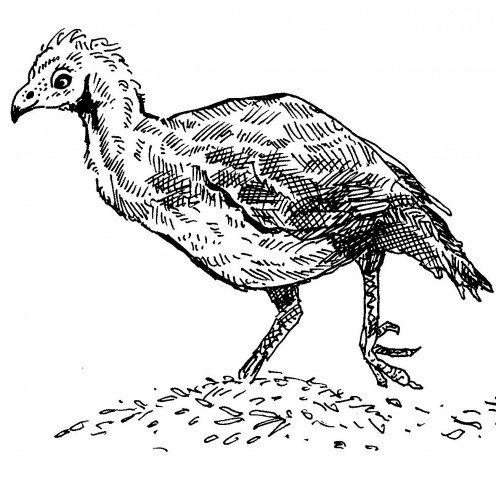
The Dusky Scrubfowl, Megapodius freycinet, is found in the north Moluccas and the Raja Ampat islands, which lie east of the Wallace Line in Indonesia. It is one of a small group of 22 species of megapodes, so called because of their large feet, but more commonly known as mound-builders or incubator birds.
Megapodes, mound-builders and the Dusky Scrubfowl
Megapodes are the only birds that do not incubate their eggs using body warmth. Instead, they build incubators from naturally occurring sources of heat: solar energy, geothermal or the heat generated by a cleverly constructed compost pile.
It is the latter means that is employed by the Dusky Megapode, which lays its eggs in a mound of decomposing leaves and twigs, covered with a layer of sand or earth.
The Dusky Scrubfowl is a medium-sized chicken-like bird approximately 16 inches in length. It is mostly black, with large brown legs. The head is red with brown eyes and a slight tuft on top. Male and female appear similar.
The Dusky Scrubfowl nests in forests, but forages in mangroves and swamps as well. It spends most of its time on the ground, but is quite capable of flights of moderate distances.

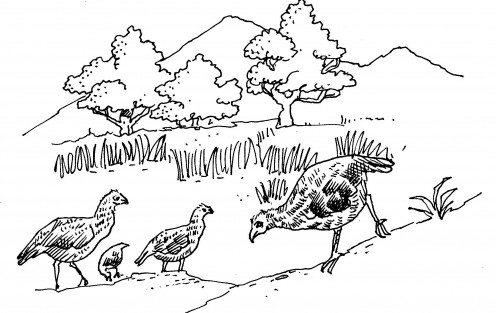
Nests of the mound-builders
Like most other megapodes, the Dusky Scrubfowl buries its eggs in a massive mound-nest made from decaying damp vegetation mixed with earth. The male constructs the nest over a period of many months and may reuse nests that had been used in previous years.
The typical first-year nest is approximately five meters in diameter and one meter high, with a slight depression in the center, most likely to funnel rain into the nest to facilitate the decomposition process.
The male periodically inserts its beak into the mound to measure temperature and humidity. It opens and closes vent holes and occasionally adds a bit more compost in order to maintain a constant 33°C (91°F) and 99.5% relative humidity.
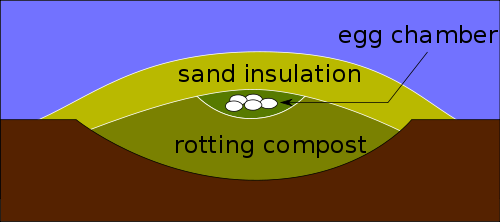
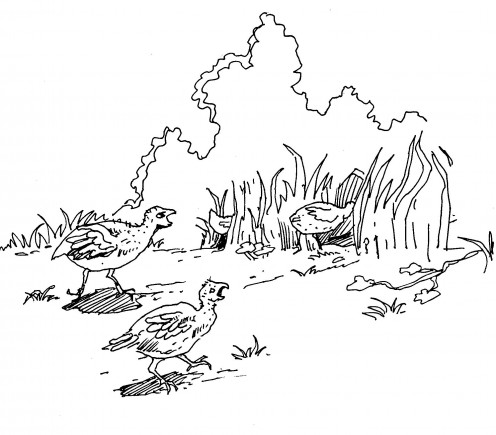
Eggs of the Dusky Scrubfowl
The female lays eggs one at a time, large in proportion to her body, over a period of months. The yolk is exceptionally large, 50–70% of the egg by weight.
The eggs hatch with no brooding or other care after two months. The chicks do not have an egg tooth to break the shell, so they emerge feet-first, clawing their way out of the shell and up to the surface of the mound.
Upon hatching, the young birds are fully developed, able to forage for food, evade predators, run and fly.
The Dusky Scrubfowl: A declining species
The Dusky Scrubfowl is quite common on Halmahera, but seldom encountered in the rest of its range: the northern Moluccas (left half of map below) and the four small Raja Ampat islands. Although the population is decreasing, it is not yet officially considered threatened. The population is declining through hunting pressure, introduced predators and destruction of traditional habitat.
Dusky Scrubfowl is common here.
Uncommonly seen now on four small islands.

Natural predators include pythons, large lizards and birds of prey. Wild pigs and feral dogs also unearth the eggs. There are further threats in areas where human settlement has encroached.
The greatest threat comes from local villagers. Eggs are considered a delicacy, but are seldom discovered at a consumable stage of development.

